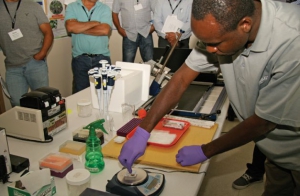
Washington State University postdoctorate student Femi Alabi demonstrates how grape tissue is analyzed for virus.
Melissa Hansen
Grapevine leafroll disease and other viruses have become a serious problem in Washington vineyards in recent years for several reasons: shortage of certified plant material during grape planting booms, spread of disease into clean vineyards from vectors like grape mealybug, improved technology that detects viruses better, and aging vineyards susceptible to crown gall.
Grape leafroll disease is economically important, because it reduces vine vigor, affecting yield and quality of grapes, and can delay fruit ripening.
This year’s grape field day held in August and sponsored by the Washington Association of Wine Grape Growers included demonstrations of how grape plant tissue is analyzed for viruses, how plant selections are screened for diseases, and how selections are propagated for planting in the foundation block housed at Washington State University’s Irrigated Agriculture Research and Extension Center in Prosser. The day included visits to a custom budwood nursery, the state’s largest certified grape nursery, and a tour of the teaching vineyard and winery of Yakima Valley Community College’s vineyard and winery technology program.
Regulatory support
For more than 40 years, the state agriculture department has implemented a certification program to provide grape growers with access to clean plant material. Inspection by state officials is required of all plant material brought into the state to protect established vineyards from unwanted diseases and pests like phylloxera. As part of the certification program, mother blocks at certified nurseries are registered with the state; department of agriculture officials inspect the blocks twice a year to look for signs of virus and test vines with suspicious symptoms. The state also conducts random testing of mother block vines.
New grapevine selections are brought into the state through the Clean Plant Center-Northwest Grapes to be tested and indexed of virus. The center provides quarantine services for grapes, along with centers for tree fruit and hops. Facilities for all three crops are located at WSU’s research station in Prosser.
After grape selections are cleared of virus, a process that can take two to three years, they are planted in the registered foundation block, also maintained by the Clean Plant Center. Commercial nurseries obtain cuttings and budwood from the registered vines for planting in their mother blocks. Each vine in a mother block must be traced to a single vine in the foundation block as part of the certification process.
In addition to being planted in the foundation block, one vine of each selection is also grown in a screenhouse at WSU for protection against vectors and winter injury.
It can take four to five years from the time the selection screening process begins to the time when budwood is distributed to commercial nurseries for propagation.
New testing
But even the certified program has not been foolproof, says Tom Wessels of the Washington State Department of Agriculture. “We’re always playing catch-up,” he said explaining the program during a tour of the Clean Plant Center. “Some of these mother blocks from the 1970s that we thought were clean of virus, now we’re finding are not. That’s because at the time, we couldn’t detect all of the viruses out there with the technology that we had.”
Also, virus could have moved into the original foundation block from vectors, he said.
Old mother blocks that have become contaminated are being phased out, and thousands of vines have already been removed.
Many grapevine diseases are difficult to diagnose based on visual symptoms. Some cultivars don’t show any signs of the disease, while others show a host of different symptoms for the same disease. Symptoms can also mimic nutritional and other problems.
“We just can’t do visuals for the mother blocks anymore,” said James Susaimuthu of the Clean Plant Center. Starting in 2012 and continuing through next year, all certified grape nursery registered (mother) blocks in Washington will be retested to confirm their virus-free status. The testing is being paid for by a $250,000 specialty crop block grant awarded to the Washington Wine Industry Foundation. In addition to the testing, the grant will support a statewide clean plant campaign to heighten industry awareness of grapevine diseases.
Bring in samples
WSU virologist Dr. Naidu Rayapati urges growers to bring suspicious-looking samples of grape leaves and petioles to his laboratory for free analysis. Rayapati, who works closely with state officials, researchers, and industry to stay on top of grapevine diseases in the state, can use information from the samples in his educational program.
“All test results brought in by growers will remain confidential,” he said, stressing that he prefers samples to go to him rather than to commercial laboratories for diagnosis. Not only does he offer testing free of charge to the grower, but he knows that the appropriate test will be conducted, and test samples will be properly run and validated.
The WSU lab uses molecular diagnostic methods to detect grape viruses. Lab technicians have established RT-PCR (reverse transcription polymerase chain reaction) assays to detect diseases, but technicians also use the ELISA (enzyme-linked immunosorbent assay) method to complement the RT-PCR results. Rayapati explained that each machine uses a different technique, so running both types of tests can improve the chances of finding single and mixed viruses.
Collecting samples is relatively easy, Rayapati said. Growers should collect mature leaves with petioles from both sides of the vine to account for uneven distribution of the virus within a plant. Place leaf samples in a zip-top plastic bag and store them in a refrigerator or under cold conditions until transported to the lab. Samples can be packed with cold packs and shipped for overnight delivery.
“Be careful to keep the samples from sitting out in the hot sun when collecting them,” he said. Identify the samples and document the vine location within the vineyard in case additional samples need to be tested.

Leave A Comment